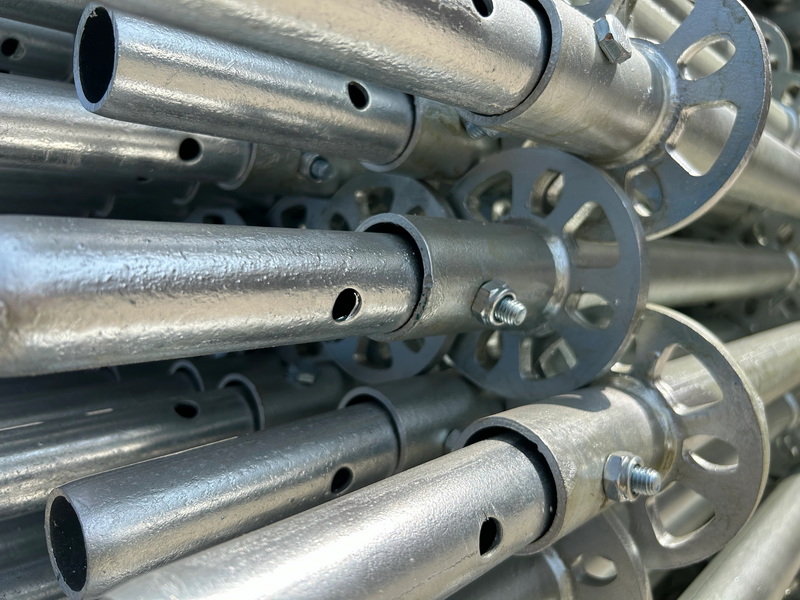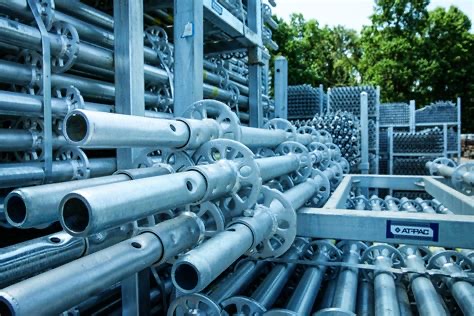Content Menu
● What is Ringlock Scaffolding?
>> Overview
>> Core Components
>> Applications
>> Benefits of Ringlock Scaffolding
● The Importance of Quality in Ringlock Scaffolding
● What is a Mill Test Certificate (MTC)?
>> Contents of an MTC
● The Role of Mill Test Certificates in Ringlock Scaffolding
>> 1. Verification of Raw Materials
>> 2. Traceability and Production Transparency
>> 3. Compliance With International Standards
>> 4. Enabling Independent Verification
● The Mill Test Certificate: Format and Standards
>> Typical MTC Formats
>> Commonly Tested Properties in MTC for Ringlock Scaffolding Steel
● Why MTCs are Essential For Ringlock Scaffolding Quality
>> 1. Preventing Use of Inferior Materials
>> 2. Passing Regulatory and Project Inspections
>> 3. Supporting Warranty and Liability Claims
>> 4. Increasing Client Confidence and Competitive Advantage
● How to Read and Verify a Mill Test Certificate
● Quality Control Workflow for Ringlock Scaffolding
>> Step-by-Step
● Real-world Implications: MTCs in Ringlock Scaffold Failure Prevention
● Certifications Beyond MTCs: Additional Approvals and Their Impact
>> National and International Scaffolding Approvals
● Conclusion
● FAQ
>> 1. What is the minimum information that must appear on a Ringlock scaffolding Mill Test Certificate?
>> 2. Are Mill Test Certificates globally recognized, or only valid locally?
>> 3. How can I ensure the authenticity of a Mill Test Certificate?
>> 4. What risks do I face if I buy Ringlock scaffolding without an MTC?
>> 5. Can poor-quality Ringlock scaffolding be detected visually, or is an MTC always necessary?
In modern construction and industrial projects, Ringlock scaffolding has become synonymous with safety, efficiency, and versatility. Whether used for high-rise buildings, bridges, industrial plants, or shipyards, the integrity and reliability of Ringlock scaffolding are paramount. Of equal importance is the assurance provided by Mill Test Certificates (MTCs), which verify the essential material properties of scaffolding components. This article explores the critical role of Mill Test Certificates in ensuring the quality and safety of Ringlock scaffolding systems, illustrating why they are indispensable for contractors, engineers, and safety officers worldwide.

What is Ringlock Scaffolding?
Overview
Ringlock scaffolding is a modular scaffolding system that assembles with remarkable speed and security, utilizing rosette connectors and wedge-head locking mechanisms. Unlike traditional tube and coupler systems, Ringlock scaffolding ensures quick assembly with fewer components and reduced labor.
Core Components
- Standards (Vertical posts)
- Ledgers (Horizontals)
- Diagonal braces
- Base jacks
- Rosette connectors
Applications
- High-rise construction
- Bridge and infrastructure projects
- Industrial maintenance
- Shipyards and power plants
Benefits of Ringlock Scaffolding
Ringlock scaffolding offers several unique benefits:
- Modular Design: Interchangeable components simplify assembly/disassembly.
- Versatility: Adaptable to different architectural shapes and complex structures.
- Load Capacity: High bearing strength and better load distribution.
- Safety: Enhanced stability due to rosette locking mechanism.
- Time Savings: Faster erection compared to traditional scaffolds reduces labor costs.
The Importance of Quality in Ringlock Scaffolding
Quality is not just a competitive advantage—it is a safety necessity. Sub-standard Ringlock scaffolding poses serious risks, including:
- Structural failures due to weak materials
- Reduced load-bearing capacity
- Increased likelihood of accidents and site stoppages
Only scaffolding that meets rigorous construction codes and industry standards can guarantee site safety and project efficiency.
Failure caused by poor material quality can lead to monumental consequences, including loss of life, costly delays, and legal challenges that jeopardize the reputation of contractors and manufacturers alike. Therefore, scrupulous attention to scaffolding quality—from material sourcing to final inspection—is essential.
What is a Mill Test Certificate (MTC)?
A Mill Test Certificate (sometimes called a Material Test Certificate or MTC) is an official document provided by manufacturers that details the chemical and mechanical properties of materials used in construction components.
Contents of an MTC
- Manufacturer's name and batch number
- Product type, dimensions, and grade (e.g., Q355 steel for Ringlock scaffolding)
- Chemical composition (percentages of carbon, manganese, silicon, sulfur, phosphorus, etc.)
- Mechanical properties (yield strength, tensile strength, elongation, toughness)
- Testing standards referenced (e.g., EN 10204 3.1 or 3.2)
- Witnessing or third-party inspection details
MTCs act like a "passport" for steel materials used in scaffolding, confirming they meet specified requirements and have undergone laboratory testing ensuring their quality and conformity.

The Role of Mill Test Certificates in Ringlock Scaffolding
1. Verification of Raw Materials
Each batch of Ringlock scaffolding components is accompanied by an MTC verifying that the steel or aluminum used complies with specified international standards. Commonly referenced grades for Ringlock systems include Q235, Q345, or Q355 steel, which must meet specific requirements for strength and ductility.
“High-quality Ringlock scaffolding typically employs Q355 steel that meets international standards. …Poor-quality scaffolding is prone to cracking, mainly due to numerous pores in the raw material…”
This ensures components are made from sound metal with minimal impurities or defects, preventing flaws that could compromise structural integrity.
2. Traceability and Production Transparency
The MTC assigns a batch number and material source, providing complete traceability from raw materials to finished Ringlock scaffolding products. In case of quality disputes or site accidents, traceability allows quick identification and recalls of affected batches.
This transparency helps manufacturers maintain accountability and fosters trust with clients, as every component can be tracked back to its origin.
3. Compliance With International Standards
MTCs prove compliance with global construction norms such as EN 12810, AS/NZS 1576, and others, which specify performance benchmarks for mechanical strength, weld quality, and safety. Regulatory bodies and large project owners almost always require valid MTCs for each shipment.
Compliance ensures scaffolding behaves as expected under load and environmental conditions, which can differ across regions, climates, or seismic zones.
4. Enabling Independent Verification
MTCs provide the documentation necessary for independent inspectors or third parties to verify the quality and suitability of Ringlock scaffolding products before use, either during factory acceptance tests or upon delivery to the construction site.
This verification stage helps prevent counterfeit or low-quality materials from reaching the field, which can be critical for projects with stringent safety requirements.
The Mill Test Certificate: Format and Standards
Typical MTC Formats
- EN 10204 3.1: Manufacturer certifies compliance based on own tests.
- EN 10204 3.2: Certificate issued with independent third-party verification (TÜV, SGS, etc.).
Commonly Tested Properties in MTC for Ringlock Scaffolding Steel
| Property | Requirement (Example: Q355 Steel) |
| Chemical Composition | C: ≤0.20%, Mn: ≤1.40%, Si: ≤0.50% |
| Yield Strength (ReH) | ≥355 MPa |
| Ultimate Tensile Strength | ≥470 MPa |
| Elongation (A5) | ≥22% |
| Impact Toughness (Charpy) | At least 27 J at room temperature |
These properties influence the steel's ductility, strength, and toughness—essential for withstanding stresses in scaffolding structures.
Why MTCs are Essential For Ringlock Scaffolding Quality
1. Preventing Use of Inferior Materials
Cases of catastrophic failure often trace back to substandard or counterfeit materials. The insistence on MTC-backed purchases ensures all Ringlock scaffolding has passed validated, repeatable laboratory tests.
Inferior materials may be prone to brittle fracture, corrosion, or deformation, undermining scaffold safety.
2. Passing Regulatory and Project Inspections
On major construction projects, local and international authorities may prohibit the use of any scaffold component lacking supporting MTCs. This applies not only to Ringlock scaffolding but to all load-bearing structural systems.
Failure to provide valid MTCs can result in work stoppages, rejections, or severe penalties.
3. Supporting Warranty and Liability Claims
Should defects, failures, or accidents arise, the Mill Test Certificate is crucial evidence in insurance, legal, and warranty proceedings—protecting both buyers and producers.
MTCs demonstrate due diligence and product compliance, which may mitigate liability.
4. Increasing Client Confidence and Competitive Advantage
Reliable suppliers who provide comprehensive MTCs position themselves as quality leaders in the scaffolding market. For clients, MTC availability signals transparency and commitment to safety, often influencing procurement decisions and contract awards.
How to Read and Verify a Mill Test Certificate
1. Check for authenticity: Ensure the certificate features company letterhead, authorized stamps, watermarks, and batch numbers.
2. Confirm standard references: Look for industry-appropriate international standards and trace them against governing codes in your region.
3. Verify material grades and mechanical properties as specified in project documents.
4. Watch for third-party inspection marks on EN 10204 3.2 certificates for maximum assurance.
5. Match batch numbers on certificates with physical component markings or delivery documentation.
Quality Control Workflow for Ringlock Scaffolding
Step-by-Step
1. Material Procurement: Require MTCs for each batch of raw material or finished component.
2. Factory Testing: Each batch undergoes further sampling and destructive/non-destructive testing.
3. On-site Inspection: Upon delivery, site engineers cross-check physical products with MTCs.
4. Installation: Only MTC-verified Ringlock scaffolding is erected on-site.
5. Ongoing Documentation: MTCs are archived for accountability and future reference.
Real-world Implications: MTCs in Ringlock Scaffold Failure Prevention
Construction audits demonstrate that sites using only MTC-backed Ringlock scaffolding experience fewer incidents of:
- Scaffold collapse due to material brittleness
- Component deformation under load
- Weld or joint failure
Conversely, projects using uncertified scaffolding can encounter costly investigation and replacement, risking project deadlines and worker safety.
Certifications Beyond MTCs: Additional Approvals and Their Impact
National and International Scaffolding Approvals
Institutes such as the DIBt (Germany), AENOR (Spain), and AFNOR (France) issue product and mixing certificates confirming that Ringlock scaffolding systems comply with national safety and performance codes. In many countries, these are legally required.
"The certificate of conformity confirms that the production of the scaffolding system has been checked and is carried out satisfactorily… a scaffolding product is reliable and safe to use."
Furthermore, scaffolding suppliers may pursue ISO 9001 certification for quality management systems. Although not mandatory, these certifications build greater confidence in scaffolding quality, documentation, and continuous improvement processes.
Conclusion
Mill Test Certificates are the backbone of modern construction quality assurance for Ringlock scaffolding systems. They provide objective, traceable proof of a component's chemical and mechanical properties, enabling engineers, contractors, and regulators to select, approve, and use scaffolding with confidence. Ignoring or compromising on MTCs is never worth the safety, legal, and financial risks involved. As global construction standards demand ever higher transparency and accountability, Mill Test Certificates are not just paperwork—they are the foundation of safe, durable, and reliable Ringlock scaffolding solutions.

FAQ
1. What is the minimum information that must appear on a Ringlock scaffolding Mill Test Certificate?
A valid MTC for Ringlock scaffolding must include at least the manufacturer's name, product description and grade, chemical composition, mechanical test results (yield and tensile strength), standards referenced, batch number, and appropriate approval or signature.
2. Are Mill Test Certificates globally recognized, or only valid locally?
Most MTCs follow internationally recognized standards (e.g., EN 10204) and are accepted worldwide. However, some countries require third-party stamps or specific local authority recognition for use on major projects.
3. How can I ensure the authenticity of a Mill Test Certificate?
Always verify that MTCs are stamped/signed by authorized parties, feature legible batch numbers linked directly to your purchased products, and reference valid international norms. For extra security, request EN 10204 3.2 certificates with third-party witness.
4. What risks do I face if I buy Ringlock scaffolding without an MTC?
Purchasing components without MTCs exposes you to risks of material failure, legal violations, costly remedial work, unsafe working conditions, and liability in case of accidents.
5. Can poor-quality Ringlock scaffolding be detected visually, or is an MTC always necessary?
Obvious signs of poor quality (rough finish, visible weld defects, unusual color, surface cracking) may show, but not all internal defects are visible. Only with MTCs and accompanying lab test data can you be certain that the product meets the strength and durability requirements.






















